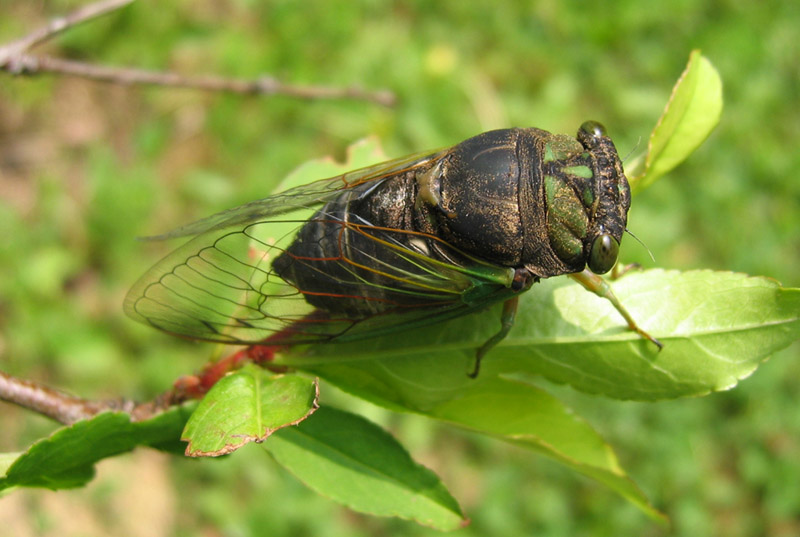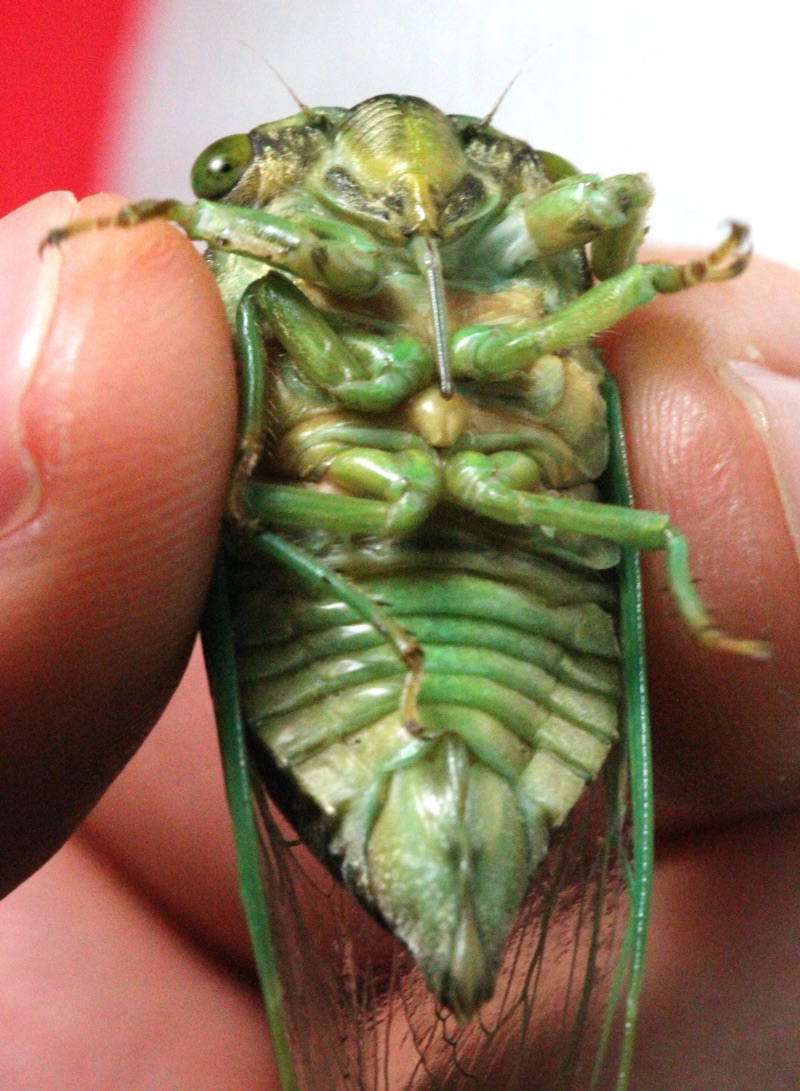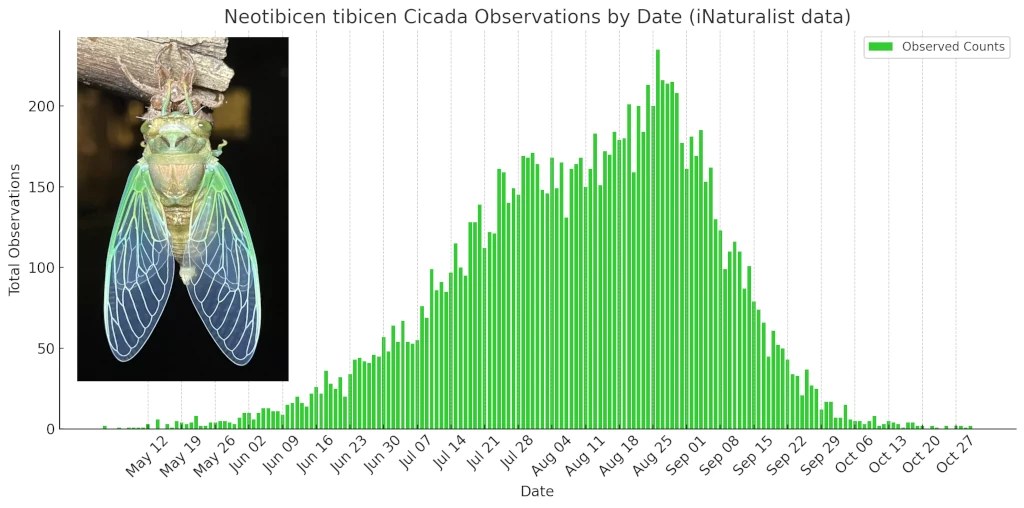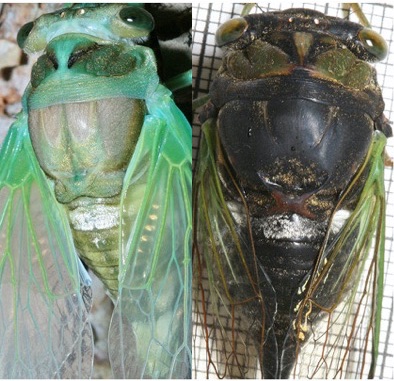Neotibicen tibicen tibicen (Linnaeus, 1758) aka Swamp Cicada or Morning Cicada. Morning because it sings in the morning. There is another sub-species of Neotibicen tibicen names Neotibicen tibicen australis. The key difference between the two is australis has a mostly green collar, while tibicen’s collar is black.

Photo by Roy Troutman. Ohio.
 Photo by Dan Mozgai. New Jersey.
Photo by Dan Mozgai. New Jersey.
See all Neotibicen tibicen tibicen images & information on cicadamania.com.
Song type: Call
Source: Dan Mozgai.
Video
Video Playlist
Playlists contain multiple videos found on YouTube.
Name, Location and Description
- Cicada Name: Neotibicen tibicen tibicen (Linnaeus, 1758)
- Short Name: N. tibicen tibicen
- Common Name: Swamp Cicada, Morning Cicada
- Synonym/Former Name: Tibicen sayi, Tibicen cholormera, Tibicen cholormerus, Tibicen tibicen tibicen
- When: June-September. Peak in August.
- Where it is found: AL, AR, CT, DE, DC, FL, GA, IL, IN, IA, KS, KY, LA, MD, MA, MI, MS, MO, NE, NJ, NY, NC, OH, OK, PA, RI, SC, SD, TN, TX, VT, VA, WV, WI
- Maps: Biogeography of the Cicadas (Hemiptera: Cicadidae) of North America, North of Mexico [PDF]
- Description: Swamp Cicadas are are known for their rounded, humped back. Their coloration varies from mostly black & some green to black, brown and green. Their collar is usually black, but can include green.
- Eye Color: black or dark green
- Pronotal Collar Color: black
- Identification: Bug Guide
- Identification: iNaturalist
- Subject Matter Expert website: Cicada Central
- Image: Insect Images
- Taxonomic Information: Integrated Taxonomic Information System
- Song: Insect Singers
When can you find them?
Here’s a chart using iNaturalist data that shows when Morning cicadas are most-often found in the U.S.:

Identification Key by Wm. T. Davis
At the time Davis wrote this key Neotibicen tibicen tibicen was named Tibicen sayi.
A. Large, heavy bodied species ; head broad, uncus simple, and first cross vein in the fore wings starting from radius 3 far back, or about one third distant from base of first marginal cell.
B. Uncus longer than broad. Black species with green or greenish markings and black area on the central part of the abdomen beneath, except in sayi [sayi = Neotibicen tibicen tibicen]
CC. Hind margin of pronotum or collar black or nearly so (except in sayi \ar. australis).
DD. Central area of the abdomen not black beneath, often
pruinose, as well as the long opercula.Collar black, often with a greenish spot each side near the outer angles sayi (Smith & Grossbeck).
Teneral (soft) and sclerotized (hard) N.tibicen tibicen
Francis Walker’s description:
This is France’s Walker’s description from List of the specimens of homopterous insects in the collection of the British Museum, Francis Walker, edited by John Edward Gray, Supplement, (2 p. l., 369, [1] p.) issued in 1858, 1850. Link to document.
Walker named the cicada Thopha chloromera, and once the Tibicen genus was constructed, its name changed to Tibicen chloromerus (Walker,1850). But… Carl Linneaus had previously named it Cicada tibicen in 1758, and once the Neotibicen genus was constructed, its name became Neotibicen tibicen (Linnaeus, 1758).
That said, Walker’s description is still valid and useful:
First cross-vein nearly straight, very slanting, forming an extremely obtuse angle, parted from the second by more than thrice its length; second curved, very slanting, forming an extremely obtuse angle, longer than the first; third slightly waved, slanting, forming a right angle; fourth slightly waved, slanting, forming an acute angle, a little longer than the third; fifth almost upright, very slightly curved, forming- a nearly right angle. Body black above, tawny and tinged with green beneath : head a little narrower than the fore-chest, adorned with several small tawny marks, and on each side of the front with one of larger size ; face slightly convex, not at all prominent, adorned with a pale tawny elliptical mark, tawny with blackish bands on each side in front : mouth tawny with a pitchy tip, reaching the middle-hips : eyes rather prominent : scutcheon of the fore-chest adorned with two oblique black stripes, which are united behind; fore border black excepting a little interval in the middle ; hind-scutcheon adorned on each side with three greenish- tawny spots, one large, the other two small ; sides not angular, but slightly excavated in front and slightly convex near the base of each fore-wing : scutcheon of the middle-chest adorned with a tawny slender double U-shaped mark whose inner sides are interrupted in front and behind ; on each side of this are two oblique tawny stripes which are united behind ; the middle pair are broader than the outer pair, and their inner sides are excavated ; hind border slightly excavated in the middle ; cross-ridge tawny : abdomen obconical, longer than the chest, black above, tawny beneath : drums very large, pale tawny, much more than half the length of the abdomen, slightly overlapping : legs green, streaked with tawny; fore-thighs armed with two stout black teeth ; spines of the hind-shanks ferruginous with black tips : wings colourless, bright green at the base ; veins ferruginous, green towards the base and along half the length of the fore border ; first and second cross-veins clouded with brown. Length of the body 17 lines; of the wings 48 lines.
Classification:
Family: Cicadidae
Subfamily: Cicadinae
Tribe: Cryptotympanini
Subtribe: Cryptotympanina
Genus: Neotibicen
Species: Neotibicen tibicen
Sub-species: Neotibicen tibicen australis (Davis, 1912)
Sub-species: Neotibicen tibicen tibicen (Linnaeus, 1758)
Map

Uses iNaturalist data + R + Leaflet | © OpenStreetMap, ODbL, © OpenStreetMap contributors.
List of sources
- Davis, W.T. 1918. Mississippi Cicadas, with a Key to the Species of the Southeastern United States. Journal of The New York Entomological Society. Vol. XXVI. Read on archive.org.
- Full Binomial Names: ITIS.gov
- Common names: BugGuide.net; The Songs of Insects by Lang Elliott and Wil Herschberger; personal memory.
- Locations: Biogeography of the Cicadas (Hemiptera: Cicadidae) of North America, North of Mexico by Allen F. Sanborn and Polly K. Phillips.
- Descriptions, Colors: personal observations from specimens or photos from many sources. Descriptions are not perfect, but may be helpful.
Notes:
- Some descriptions are based on aged specimens which have lost some or a lot of their color.

3 replies on “Neotibicen tibicen tibicen (Linnaeus, 1758) aka Morning Cicada”
I live in suburban Montgomery County Maryland and I grew up hearing a cacophony of annual cicadas every summer. This year they seem scarce. In the late afternoon and evening long periods go by when I don’t hear any at all, and August is their peak season, isn’t it? Is this a normal variation in population? I hope they’re not dying out like the fireflies.
Is it normal to hear these in May? I heard and saw some on May 29, 2022.
Some may come out early, like this case. It all depends on weather conditions, so it’s pretty unpredictable. I have seen another case where T. pruinosus emerged and was calling in Magicicada season.
So no, it’s pretty rare that this occurs